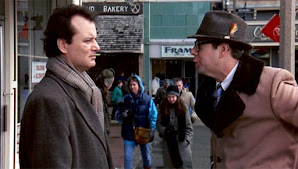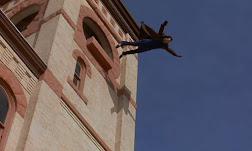It’s February, the month of Valentines … and by a lesser extent, it’s also the month of Groundhog Day. While I may be a few days behind, I still felt like the occasion was right to review one of the great classic comedies of the 90’s … the one that just happens to be set on the big event of February 2nd. The 1993 classic “Groundhog Day” is one of those rare comedies to take on a life of its own, and leave an impression on a larger crowd outside of genera fans.
Director Harold Ramis and star Bill Murray were still ridding the success of hit comedies from the 80’s, including “Caddyshack”, “Stripes”, and “Ghostbusters”, so it was a safe bet that the two were going to deliver another funny hit with “Groundhog Day” … and then audiences got that little extra appeal that stuck with them more then the laughs. Speaking personally for a moment, when I first saw this movie, I was just a kid, and I never gave the film a second viewing until years after I graduated from college. Yet, in that time, I always remembered the film, occasionally thought back on it, as it left a simple, yet special impression that stuck with me over all those years. As such, while I wouldn’t label “Groundhog Day” as one of my favorite movies, I never the less have a connection with the film, and when a movie can stick with me without repeat viewings, I know it did something special that’s well worth discussing.
Bill Murry stars as a nasty, cynical, people hating TV weather man named Phil Conners, who never once attempts to have a social life, and treats each day like a disposable event. Everything changes on one of many unremarkable February second news days, in which he reluctantly covers the annual Groundhog Day celebration, and once again dismiss any chance of spending social time with his fellow co-workers. It was all fairly standard at first … until the next morning, in which it’s suddenly Groundhog Day all over again, and everything is the same down to the last detail. It’s plenty irritating at first, but things only escalate, as for the next 34 days, it will be the exact same February second all over again. Naturally, the effect takes quiet the tole on Phil, and we see with each day all the different ways he reacts, changes and, adapts to this most unusual situation. In the end, it takes these several Groundhog Days for him to finally emerge a different … and better person then he was before.
It’s worth noting that “Groundhog Day” wasn’t the first to utilize to premise of being stuck in a day that’s on repeat, in fact one of my favorite episodes of “Star Trek: The Next Generation”, titled “Cause and Effect”, had a similar premise revolving around a day that’s going through a loop, and that came out a year before the movie.
However, even though “Groundhog Day” didn’t invent the formula, it’s unmistakably the most famous to utilize it, to the point where it’s now almost universally regarded as “the Groundhog Day formula” … which as far as I’m concerned is the absolute best thing to come from the holiday. In general, I always found the holiday itself to be very disposable, dismissive, and as such, I think it was a stroke of genius to set this film on the selected event of February second. I’m sure it was tempting for Harold Ramis, and fellow screen writer Danny Rubin to set this film on Christmas, which could have worked, but I don’t think it would’ve been quiet as unique, special or even as memorable if it was set on the more famous holiday. Just as a quick side-note, I was actually introduced to this formula for the first time through a Christmas special staring Donald Duck called “Stuck on Christmas”, and in its own right, it did still compliment the holiday quiet well. However, what I feel put’s “Groundhog Day” above all the others with this premise is its brilliant set-up, in that even day one was figuratively a repeat day in-of-itself. It was just going to be one of many thankless days in which our main character never changes, and stays within the same dismal loop that was his life. As such, it took a single day going through a loop that finally purpled him to move forward with his life, and break the figurative loop of his own making.
It’s a clever piece of writing to have a single repeated day that remains exactly the same, which is then contrasted with the individual person going through this loop, as he’s gradually changing with each morning, and that’s where the strength of this film lies. The formula of a constantly repeating day could have been, well … repetitive … to say the least, but through this, we get to see the full evolution of a single individual, as he goes from a zero to a ten. We see his confused faze, trying to figure out how to break the cycle.
We see his selfish faze, in which he acts out all the extremes he could never get away with before, whether it be stealing money or driving his car like a fanatic. We see his desperate faze, in which he so badly wants to get out of this loop, to the point where he goes through with various suicide attempts. We then see his heroic side, as he takes note of what he can do better, and tries his best to make the most of what he’s got, by being their for others. He also breaks his own anti-social barriers through a romantic relationship with one of his co-workers named Rita. Everything effectively builds to this beautiful little moment when one of Phils close friends casually comments, “I think this was the best day of my life”, in which Phil humbly responds with “Me too”. It’s at that moment, we know he’s broken the cycle, and that tomorrow is going to be a new day.
There’s a number themes running throughout the movie, most obvious being the general sentiment that a person working a daily job, or maybe just has a familiar daily schedule, can feel like they’re just living each day onward without any forward momentum. This is visually highlighted best with the digits on the alarm clock flipping over, and slamming down to reveal it’s 6:00 again. It’s an impactful image that’s always lingered in my subconscious, as when I have those days of waking up early for work, or back when I was going to school, I always felt that image flash before my eyes, as if to say … yup, it’s another day again. Yet, what this film so cheerfully encourages the viewer, is that they have the power to break their own figurative loops, and can move forward with some subtle changes, like bringing others into their lives, or being less dismissive of people who could potentially be a best friend.
Where “It’s a Wonderful Life” can be described as a story of a person reflecting on his life, and finally taking notice of what he did right, “Groundhog Day” can be described as a story of one person keeping at it, until he gets his life just right. Another meaningful theme in play is that of savoring each moment while they last, as they’ll never come again, which is very thoughtful for a movie revolving around a day that’s on repeat. This statement is highlighted best when Phil for once has a night in which he breaks the narrative, and has a special romantic moment with his girlfriend Rita, while they play around in the snow. It’s a very sweet and wholesome moment, but the next night, Phil tries to replicate all the same beats, and now it’s awkward, doesn’t feel as natural as before, and ends on a dismal note, as opposed to the previous night. That’s what I love most about this movie, in that it’s a light and upbeat experience, but with those meaningful little nuggets in all the details that we can relate to, or maybe even learn from. In general, I think it was a stroke of genius to make this movie a comedy first, that way the message can be there in the details, but without feeling forced or manipulative, which could have likely been the case, if this movie were presented as a more serious character drama.
As far as my feelings for comedies are concerned, “Groundhog Day” never quiet produced any big belly laughs in me, but it keeps me smiling, and just leaves me feeling good afterword’s, and sometimes that’s all I really need. It’s definitely one of those cases in which the experience is more cheerful than it is laugh-out-loud funny. For it’s time, “Groundhog Day” became something of a forerunner for comedies that have fantastical elements woven through the narrative … one of my favorite examples of the time being Jim Carries 1997 comedy “Liar Liar”. The casting of Bill Murray ended up being an equally inspired choice, as he easily brings all the laughs, as he reacts differently to each day, but he also delivers the convincing transformation of a man who naturally learns to make the best of himself. Andie MacDowell also has good chemistry with him as love interest Rita. Chris Elliott is given a smaller role as a cameraman, yet still makes the most of it. It’s also cool that Bill Murrays brother, Brian Doyle-Murray has a supporting role as the towns Mayor named Buster Green. Lastly, as a long time fan of the animated TV series "Teen Titans", it's special to see Hynden Walch, the voice of Starfire, in a small role as a young bride.
In the end, “Groundhog Day” was a special little accomplishment for its time, and I feel it’s held up … not just as a classic comedy … but just a sweet little movie on its own grounds, and is well worth watching at least once if you haven’t seen it yet. I can speak from my own experience that it’s a movie you only need to see once, and it’ll still stick with in one way or another. For me, it’s only gotten better as I’ve gotten older, both as a cheerful experience, and as something to take merit from. Even if you’re not one for comedies, I’d still encourage you to give this film a chance … and who knows, maybe it’s just the experience you’ll need … to encourage you to make tomorrow … feel like a new day.
Thanks for
reading my review of the 1993 comedy classic “Groundhog Day” … and
continue to enjoy the movies you Love!




































